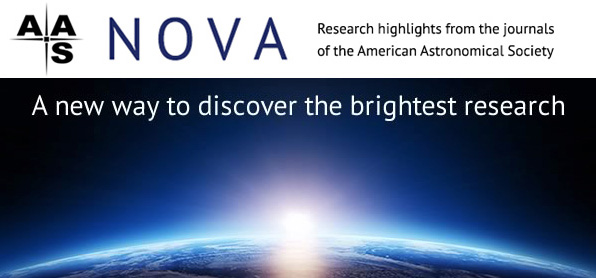Highlights from AAS Nova: 12-25 November 2017

Susanna Kohler American Astronomical Society (AAS)
AAS Nova provides brief highlights of recently published articles from the AAS journals, i.e., The Astronomical Journal (AJ) and The Astrophysical Journal (ApJ), ApJ Letters, and ApJ Supplements. The website's intent is to gain broader exposure for AAS authors and to provide astronomy researchers and enthusiasts with summaries of recent, interesting research across a wide range of astronomical fields.
The following are the AAS Nova highlights from the past two weeks; follow the links to read more, or visit the AAS Nova webpage for more posts.
22 November 2017
Analog of the Milky Way and the Magellanic Clouds
A hunt for merging dwarf galaxies has yielded an intriguing result: 180 million light-years away, a galaxy very similar to the Milky Way — with two dwarf-galaxy satellites just like our own Magellanic clouds.
21 November 2017
Protoplanetary Disks Might Be More Turbulent than Thought
How do the protoplanetary disks surrounding newly formed stars eventually disappear? Astrobites reports on the role that turbulence in the disks might play.
20 November 2017
Kepler Planets Tend to Have Siblings of the Same Size
Exoplanets in Kepler multiplanet systems tend to be “peas in a pod”: planets within the same system often have similar radii. A new study explores this odd behavior.
17 November 2017
LIGO Finds Lightest Black-Hole Binary
LIGO has announced the discovery of the lightest pair of black holes we’ve ever seen merge, allowing us to compare these to the black holes detected by electromagnetic means.
15 November 2017
A Look at the Milky Way’s Outskirts
We may be stuck in the Milky Way’s interior, but we can use distant variable stars to map out a picture of what’s happening in the outskirts of our galaxy.
14 November 2017
Can We Detect Auroral Emission from Proxima b?
A planet’s aurorae (like the northern lights on Earth) can tell us about the planet itself — but we’ve never before detected aurorae from an exoplanet. Astrobites reports on the prospect of observing aurorae from Proxima Centauri b.
13 November 2017
Featured Image: Nuclear Star Clusters in Virgo
Many galaxies host extremely dense clusters of stars in their cores. Observations of these clusters help us explore how they might have formed.


